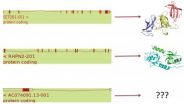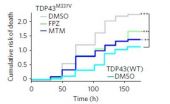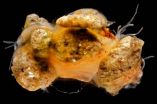(Press-News.org) AURORA, Colo. (July 3, 2014) – Physicians from the University of Colorado School of Medicine in collaboration with an international team of researchers have demonstrated that screening of genetically susceptible infants can lead to the diagnosis of celiac disease at a very early age.
The collaborative group studied 6,403 children with specific genetic markers from birth to identify the factors involved in the development of both celiac disease and type 1 diabetes. The children are from the United States, Finland, Germany and Sweden and are part of The Environmental Determinants of Diabetes in the Young (TEDDY) study. Interestingly, the study also found that Swedish residents had a higher risk for celiac disease than their European neighbors in Finland and Germany, and a nearly two-fold higher risk of celiac disease than their U.S. counterparts, despite sharing the same high-risk celiac genes.
Celiac disease is an autoimmune disease that damages the small intestine and interferes with absorption of nutrients from food. It can sometimes develop silently, leading to long-term medical complications if left untreated. People who have celiac disease cannot tolerate gluten, a protein in wheat, rye, and barley. Gluten is found mainly in foods but may also be found in everyday products such as medicines, vitamins, and lip balms.
The study is published in the July 3 issue of The New England Journal of Medicine. The research was funded by the NIH, the Juvenile Diabetes Research Foundation and Centers for Disease Control and Prevention.
Edwin Liu, MD, associate professor of pediatrics at the University of Colorado School of Medicine and lead author of the study, said the findings are significant because it will help determine when screening should begin in at-risk children. In addition, it will allow the group to explore factors that may be causing Swedish children to develop celiac disease at a higher rate than other countries.
"The findings in this report set the stage for the study of complex relationships between genetic, environmental and gestational factors that may play a role in the development of celiac disease in early childhood," said Liu, who is the Taplin Endowed Chair for Celiac Disease and director of the Colorado Center for Celiac Disease at Children's Hospital Colorado.
Marian Rewers, MD, PhD, the principal investigator of TEDDY, and the late George Eisenbarth, MD, PhD, both from the Barbara Davis Center for Childhood Diabetes, are co-authors of the study. The senior author and leader of the Celiac Disease Committee within TEDDY is Daniel Agardh, MD, PhD, from Lund University in Sweden. Other contributors to the study are from the University of South Florida, the Pacific Northwest Diabetes Research Institute in Seattle, Ludwig-Maximilians-University in Germany, the University of Bristol in the United Kingdom, Dresden University in Germany, the University of Turku in Finland and members of the TEDDY Study Group.
The primary goal of TEDDY is to find the causes of type 1 diabetes and celiac disease. TEDDY has screened more than 425,000 infants who are at high risk for type 1 diabetes, eventually following the health of 8,677 children among more than 20,000 eligible to participate. Because the major genetic factors that confer risk for type 1 diabetes are shared by celiac disease, researchers are evaluating this group for development of celiac disease.
INFORMATION:
Faculty at the University of Colorado School of Medicine work to advance science and improve care. These faculty members include physicians, educators and scientists at University of Colorado Hospital, Children's Hospital Colorado, Denver Health, National Jewish Health, and the Denver Veterans Affairs Medical Center. The school is located on the Anschutz Medical Campus, one of four campuses in the University of Colorado system. To learn more about the medical school's care, education, research and community engagement, visit its web site.
Study finds higher risk for celiac disease in some children
2014-07-03
ELSE PRESS RELEASES FROM THIS DATE:
Biological signal processing: Body cells -- instrumentalists in a symphony orchestra
2014-07-03
Every organism has one aim: to survive. Its body cells all work in concert to keep it alive. They do so through finely tuned means of communication. Together with cooperation partners from Berlin and Cambridge, scientists at the Luxembourg Centre for Systems Biomedicine (LCSB) of the University of Luxembourg have now successfully revealed for the first time the laws by which cells translate signals from their surroundings into internal signals. Like an isolated note in a symphony orchestra, an isolated signal in the cell is of subordinate importance. "What is important ...
A CNIO team reduces the size of the human genome to 19,000 genes
2014-07-03
How nutrients are metabolised and how neurons communicate in the brain are just some of the messages coded by the 3 billion letters that make up the human genome. The detection and characterisation of the genes present in this mass of information is a complex task that has been a source of ongoing debate since the first systematic attempts by the Human Genome Project more than ten years ago.
A study led by Alfonso Valencia, Vice-Director of Basic Research at the Spanish National Cancer Research Centre (CNIO) and head of the Structural Computational Biology Group, and ...
Could boosting brain cells' appetites fight disease? New research shows promise
2014-07-03
ANN ARBOR, Mich. — Deep inside the brains of people with dementia and Lou Gehrig's disease, globs of abnormal protein gum up the inner workings of brain cells – dooming them to an early death.
But boosting those cells' natural ability to clean up those clogs might hold the key to better treatment for such conditions.
That's the key finding of new research from a University of Michigan Medical School physician scientist and his colleagues in California and the United Kingdom. They reported their latest findings this week in the journal Nature Chemical Biology.
Though ...
Ironing out details of the carbon cycle
2014-07-03
Iron is present in tiny concentrations in seawater. On the order of a few billionths of a gram in a liter.
"I did a calculation once on a ton of ocean water," says Seth John, an assistant professor in the department of marine science at the University of South Carolina. "The amount of iron in that ton of water would weigh about as much as a single eyelash."
Given that there is so little iron in seawater, one might conclude that its presence there is inconsequential.
Hardly. Iron is one of the essential elements of life. Found in enzymes like myoglobin and hemoglobin ...
Science Elements podcast highlights the science of fireworks
2014-07-03
The July feature of Science Elements, the American Chemical Society's (ACS') weekly podcast series, shines the spotlight on the science of fireworks, just in time for the July 4th holiday. The episode is available at http://www.acs.org/scienceelements.
Independence Day is a time for picnics, parades and, of course, fireworks. Those beautiful explosions in the sky would be nothing without chemistry. In today's episode, Science Elements talks to the man who literally wrote the book on fireworks.
"Everything you see in a fireworks display is chemistry in action," says ...
Decade of benefits for the Great Barrier Reef
2014-07-03
With this week marking the tenth anniversary of the rezoning of the Great Barrier Reef Marine Park, prominent marine scientists from around the world have gathered in Canberra to discuss its successes - both expected and unexpected.
"At the time, the rezoning of the Great Barrier Reef Marine Park was the largest marine conservation measure in the world," says Professor Garry Russ from the ARC Centre of Excellence for Coral Reef Studies (Coral CoE). "The Reef went from being five percent protected to about 30 percent. So now, a third of it is green, or no-take, zones."
Designed ...
Lessons from the west: Great Barrier Reef in danger
2014-07-03
Scientists at a coral reef symposium in Canberra this week are examining degraded reefs off the Northwest Australian coast in an effort to determine what lies ahead for the Great Barrier Reef.
"Reefs north of Exmouth have experienced large-scale bleaching in the past five years," says Professor Malcolm McCulloch from the ARC Centre of Excellence for Coral Reef Studies (Coral CoE) at the University of Western Australia.
McCulloch is in the midst of an autopsy of this Pilbara bleaching event, collecting and analysing both living and dead stony coral. He says the bleaching ...
Forecasting the development of breakthrough technologies to enable novel space missions
2014-07-03
A new report, Technological Breakthroughs for Scientific Progress (TECHBREAK), has been published today by the European Science Foundation.
The European Science Foundation (ESF) was contacted at the end of 2009 to conduct a foresight activity for the European Space Agency (ESA), addressing the matter of technological breakthroughs for space originating in the non-space sector. A "Forward Look" project jointly funded by ESA and ESF and called 'TECHBREAK' was initiated as a result. Its goals were to forecast the development of such breakthrough technologies to enable novel ...
Researchers from the UCA prove the existence of large accumulations of plastic in all of the oceans
2014-07-03
Researchers from the University of Cadiz have made an unprecedented discovery: they have shown that there are five large accumulations of plastic debris in the open oceans, coinciding with the five main ocean gyres in the surface waters of the ocean. As well as the well-known accumulation of plastic rubbish in the North Pacific, these experts have proven the existence of similar accumulations in the centre of the North Atlantic, the South Pacific, the South Atlantic and the Indian Oceans. And they have gone one step further to state that the surface water of the centre ...
'Work environment' affects protein properties
2014-07-03
Under the tutelage of Junior Professor Dr Simon Ebbinghaus, researchers from Bochum have demonstrated that the water surrounding the dissolved substances inside the cell plays a crucial role with regard to protein stability, which has frequently been neglected in the past. The researchers have published the results of their study, gained by means of simple model systems and thermodynamic analyses, in the Journal of the American Chemical Society (JACS). The results have been obtained following a collaboration under the umbrella of the Excellence Cluster RESOLV. The researchers ...




